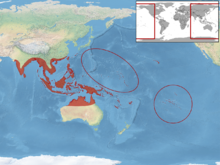
Back Cekcek umah BAN Tabili BCL Hemidactylus frenatus Bulgarian টিকটিকি Bengali/Bangla Hemidactylus frenatus CEB Asiatischer Hausgecko German Hemidactylus frenatus Spanish Hemidactylus frenatus Basque مارمولک خانگی آسیایی Persian Hemidactylus frenatus French
| Common house gecko | |
|---|---|

| |
| Scientific classification | |
| Domain: | Eukaryota |
| Kingdom: | Animalia |
| Phylum: | Chordata |
| Class: | Reptilia |
| Order: | Squamata |
| Family: | Gekkonidae |
| Genus: | Hemidactylus |
| Species: | H. frenatus
|
| Binomial name | |
| Hemidactylus frenatus | |

| |
The common house gecko (Hemidactylus frenatus) is a gecko native to South and Southeast Asia as well as Near Oceania. It is also known as the Asian house gecko, Pacific house gecko, wall gecko, house lizard, tiktiki, chipkali[3] or moon lizard.
These geckos are nocturnal; hiding during the day and foraging for insects at night. They can be seen climbing walls of houses and other buildings in search of insects attracted to porch lights, and are immediately recognisable by their characteristic chirping.
They grow to a length of between 7.5–15 cm (3–6 in), and live for about 7 years. These small geckos are non-venomous and not harmful to humans. Most medium-sized to large geckos are docile, but may bite if distressed, which can pierce skin. The common house gecko is a tropical species, and thrives in warm, humid areas where it can crawl around on rotting wood in search of the insects it eats, as well as within urban landscapes in warm climates. The animal is very adaptable and may prey on insects and spiders, displacing other gecko species which are less robust or behaviourally aggressive. In parts of Australia and Papua New Guinea they are often confused with a similar native lizard, the dubious dtella.
- ^ Ota, H.; Whitaker, A.H. (2010). "Hemidactylus frenatus". IUCN Red List of Threatened Species. 2010: e.T176130A7184890. doi:10.2305/IUCN.UK.2010-4.RLTS.T176130A7184890.en. Retrieved 8 June 2018.
- ^ "THE REPTILE DATABASE". Retrieved 2022-03-09.
- ^ "Hemidactylus chipkali".
© MMXXIII Rich X Search. We shall prevail. All rights reserved. Rich X Search
